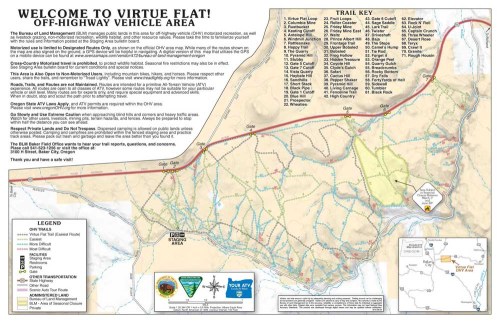ATV wash station planned at Virtue Flat
Published 2:15 pm Monday, January 17, 2022

- Map of the Virtue Flat Off-Highway Vehicle Area shows the part closed yearly from March 1 to June 30 to protect sage grouse habitat.
BAKER CITY — Motorcycles and four-wheelers don’t pose an immediate threat to sage grouse, given that the birds are pretty nimble, but motor vehicles can potentially cause indirect problems for the grouse, a longtime candidate for federal protection.
Vehicles can carry seeds of noxious weeds on their tires or undercarriages, spreading invasive species over wide areas and making habitat less usable for sage grouse.
To reduce that risk in the most popular riding area near Baker City — Virtue Flat Off-Highway Vehicle Area, about 7 miles east of town — a local team tasked with preserving sage grouse habitat plans to build a wash station at Virtue Flat where riders can clean their vehicles for free. The schedule calls for construction to start in the spring of 2023.
The goal is to reduce the spread of noxious weeds, including annual grasses such as cheatgrass and medusahead that grow in parts of the area, said Dallas Hall Defrees, coordinator of the Baker County Sage Grouse Local Implementation Team.
The source of the water for the wash station isn’t certain, she said, although it’s possible that water would have to be hauled to a storage tank.
The LIT, which includes private landowners as well as officials from local, state and federal agencies, is overseeing a $6.2 million, six-year grant from the Oregon Watershed Enhancement Board to help sage grouse in the county.
The Watershed Enhancement Board gets its money from Oregon Lottery revenue.
Cheatgrass and other noxious weeds can crowd out the sagebrush and native grasses and other plants that sage grouse depend on for shelter and for food.
The Virtue Flat OHV area, which includes more than 50 miles of trails, also encompasses sage grouse habitat.
A portion of the area, which is managed by the Bureau of Land Management, is closed yearly from March 1 to June 30 to protect sage grouse during their mating season.
Defrees said that although the wash station will help curb one potential source of noxious weed spread, it’s only one strategy to preserve sage grouse habitat.
The Baker County Sage Grouse LIT has spent money from the state grant to control noxious weeds on almost 6,000 acres in the county, to plant native grasses on 850 acres and to build 6.5 miles of fence to control livestock grazing.
“It is a multi-pronged approach that the Baker LIT is taking in order to preserve and improve our rangelands — striving to maintain the agricultural backbone of Baker County,” Defrees said. “The Baker LIT will continue to work with private and public landowners to promote a more resilient landscape to wildfire and weed encroachment, all while increasing forage and habitat for sage grouse.”
Defrees asks people who use the Virtue Flat OHV area to complete an online survey about the wash station at https://fs9.formsite.com/v1Yjj4/6x8b5g0qpx/index.html.
The Baker LIT is working with the Bureau of Land Management, Baker County, Oregon Department of Fish and Wildlife and U.S. Fish and Wildlife Service on the wash station project.
Sage grouse in Baker County
Baker County’s sage grouse situation is unique in Oregon in that the majority of the bird’s habitat here is on private property. Baker County is at the northern fringe of the sage grouse’s range in Eastern Oregon, and the county’s sage grouse population accounts for less than 10 percent of Oregon’s total.
Most of the bird’s habitat and population in the state are in the southeastern counties of Lake, Harney and Malheur, which are predominantly public land.
Environmental groups have repeatedly asked the federal government to classify the bird as a threatened or endangered species, a decision that could curtail activities, including cattle grazing and motorized vehicle use on public land, that could degrade sage grouse habitat.
In September 2015 the U.S. Fish and Wildlife Service decided not to list the bird as threatened or endangered.
A Baker County group has been working for several years to study why the county’s sage grouse population declined by about 70% over a decade ending around 2019.
Baker County Commissioner Mark Bennett, who has sought to improve sage grouse habitat on his cattle ranch near Unity, said Marisa Meyer, a wildlife biologist with the U.S. Fish and Wildlife Service in La Grande, and Nick Myatt, who manages the Grande Ronde Watershed District for the Oregon Department of Fish and Wildlife (ODFW), were instrumental in starting the Baker County Sage Grouse Local Implementation Team that applied for the Lottery dollars through the Watershed Enhancement Board.
The team has used the state grant not only for projects in the county, but to leverage federal dollars for other work.





